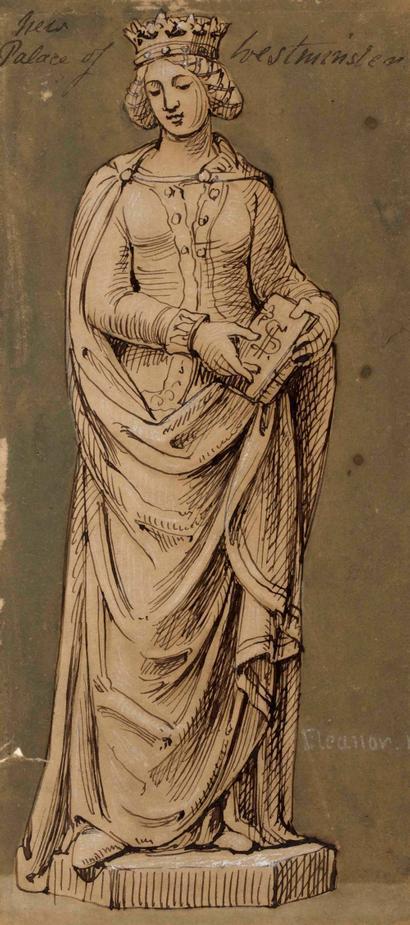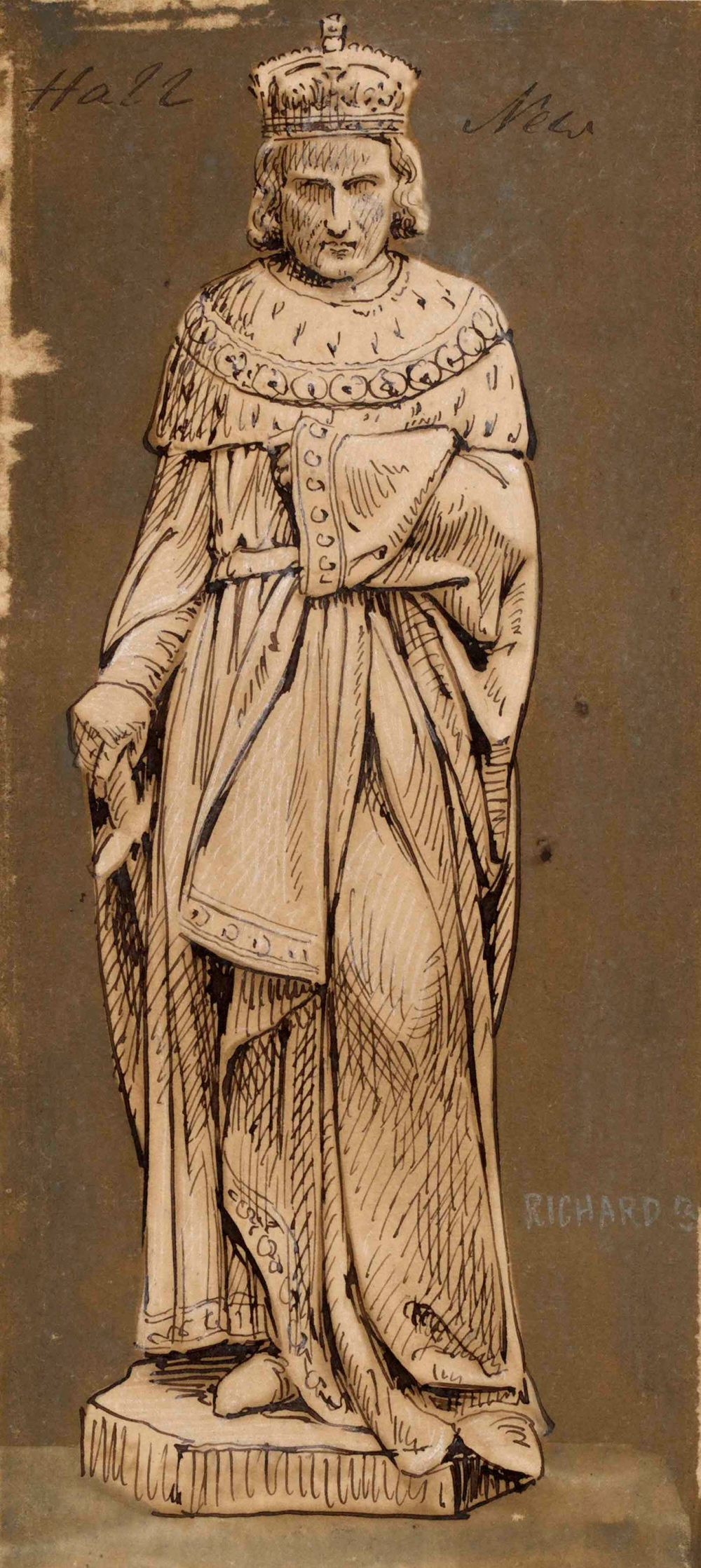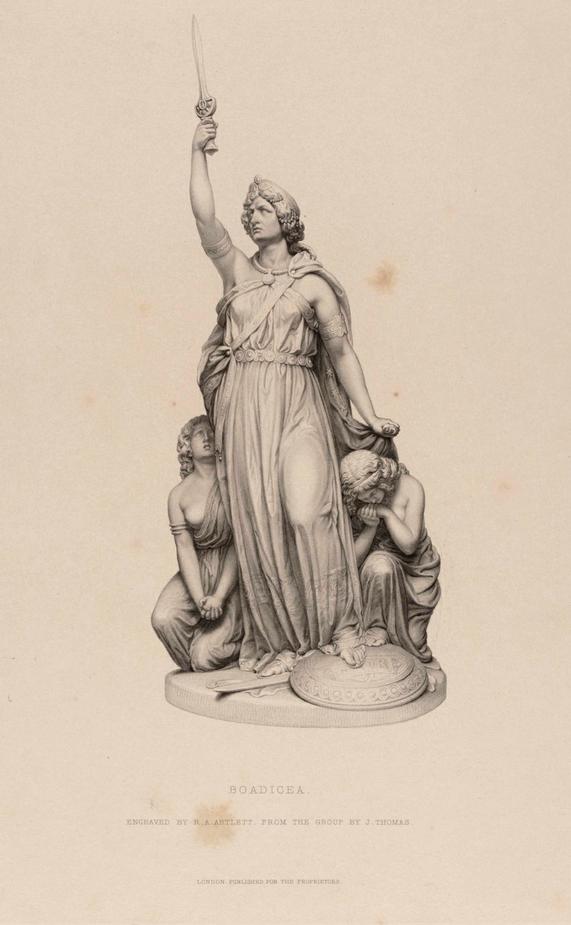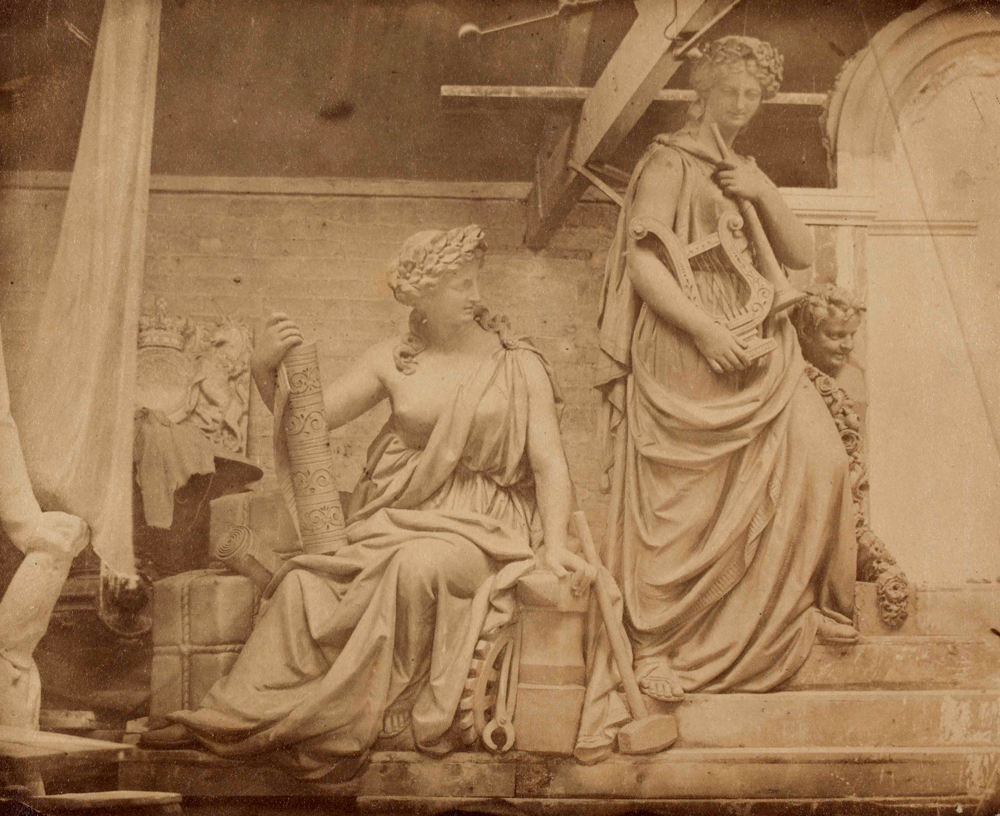Abstract
One of the myriad pleasures of working in a museum such as the V&A is the way in which appreciation of an object, such as the sculpture ‘Rachel, the Daughter of Laban’, by John Thomas (1813–1862), can be renewed by something as simple as a modest change in presentation. This brief article aims to investigate how the apposite object label, intelligent lighting, and the correct plinth, can help us to rethink the past.

A good example of this was the decision in 2009 to move two sculptures from a dingy corner in one of the Museum’s lobbies on Exhibition Road to niches in the corridor which leads visitors towards the temporary exhibition galleries. The whole space was relit and painted in celebration of its robust 19th-century proportions and tiled floor and what was once a mere transit space acquired an elegant air. The sculptures acquired new plinths, at a height carefully calculated by curators and the design teams to display the object to best effect.
The sculpture, ‘Rachel, the Daughter of Laban’, by John Thomas (1813–1862) (fig. 1), has particularly benefited from this apparently unassuming project.2 The biblical matriarch now regularly catches the eye of exhibition visitors and one often sees them intrigued by the composition. They might be similarly interested to learn how its acquisition demonstrates the museum’s consistent good fortune in enjoying the generosity of donors, and how Thomas himself provides an engaging 19th-century tale of the rapid progress of a man of design from humble roots: a tale that includes a lost masterpiece, an art-historical puzzle and a suitably melancholic ending. This article also affords an opportunity to celebrate the benefits of the V&A-RIBA partnership, because both institutions hold drawings by John Thomas, and it has been possible to illustrate this article with examples from these holdings, all of which have been digitised for the first time.3
In 1885 Sir Henry Hunt, an important patron of John Thomas’ work, wrote to the Director explaining that this ‘beautiful piece’ was displayed in the conservatory of his London home in Eccleston Square, but as he was giving up his house, and was reluctant to sell the work, he preferred to offer it for display either at South Kensington or Bethnal Green.4 Sir Henry had enjoyed a prominent career as a building surveyor, advising on a wide range of landmark projects. Most notably the new Palace of Westminster - and he had been knighted in 1876 for public service.5 Rachel had been exhibited at the Summer Exhibition of 1856 and it is possible, especially given the close connection between Hunt and Thomas, that Hunt had acquired the work at that time.6 The sculpture was duly inspected by George Wallis, senior keeper of the art collections, who considered it ‘one of the best, perhaps the best work, I have seen by this artist’ and having declared that it was ‘well worth acceptance as a work of modern sculpture’, Rachel was accessioned later that year.7
A prosperous baronet’s gift to a great national museum, contrasts sharply with the simple early life of the sculptor that made it. Thomas was born in Chalford, Gloucestershire, 1813, and, being orphaned at thirteen, he was apprenticed to a local stone cutter. An early appreciation of his work claims, rather mawkishly, that ‘anxious not to be a burden to anyone’ the boy devoted his evenings to engraving brass-plates and lettering grave-stones.8 True to our Victorian narrative, virtue was rewarded when, several years later, Thomas was working as a craftsman on the King Edward VI Grammar School in Birmingham. Its architect, Charles Barry, had been frustrated by delays in the supply of original models for workmen to use in executing ornamental bosses and so was delighted when Thomas took the initiative of making one himself. Barry was so impressed that he engaged Thomas for his Palace of Westminster project and also sent him on a tour of Belgium to inspect Gothic buildings.9
Thus began a rapid ascent in status for the sculptor. By 1848, at the young age of 28, he was supervising carving at the Palace of Westminster and was formally appointed superintendent in 1846. His industry and skill were vital because the sculptural programme was so extensive and complex: monarchs, angels, heraldic animals, coats of arms, were all to be sited on major elevations and set in a rich gothic context (figs 2–4).10 At the same time, playing such a central role in executing and designing one of the great public works of the century afforded him ample opportunity to acquire private patrons.

Two eminent figures were vital to his continued success. First was Sir Morton Peto, the enormously successful and wealthy contractor for railways and public works. Peto had worked with Barry on the grammar school in Birmingham, and they collaborated again on the Westminster scheme. He also worked closely with Thomas, and in 1844 commissioned him to rebuild Somerleyton Hall, in Lowestoft (fig. 5).
Peto would later have to leave the vast mansions when he endured a spectacular bankruptcy in 1866 arising from failed railway investments, lamented by The Times as a ‘national humiliation’.11 Such a man, and such a mansion, required impressive art and Peto commissioned a sculptural group Queen Boadicea and Her Daughters which was exhibited at the Royal Academy Summer of 1855.12 Alas, it is currently untraced, and one can only hope that it may yet emerge; engravings in the RIBA Collection suggest that it was a bravura composition (fig. 6).
The connection with Peto brought Thomas into contact with other entrepreneurs, such as his business partner Edward Ladd Betts, for whom Thomas was to build Preston Hall in Kent. Betts also proved to be an avid commissioner of Thomas’s marble sculpture.13 Yet, while such connections undoubtedly brought prosperity, it was the encounter with his most illustrious architectural patron, Prince Albert (fig. 7) that was to bring exceptional prestige.
The Prince was deeply engaged with the Westminster project through his Chairmanship of the Royal Fine Arts Commission, and doubtless encountered Thomas through this enterprise. Thomas was to receive several royal commissions and was said to have enjoyed a respectful relationship with his energetic patron. The Prince appreciated his simplicity of character and Gloucestershire accent, describing him as a ‘man of consummate ability, utterly without conceit or arrogance’.14 More tellingly, the Prince may have relished the opportunity to see his own wishes carried out precisely, without enduring the prickly professional pride of some contemporary architects.
Thomas’s Royal commissions included reliefs of War and Peace for the interior of Buckingham Palace and the remodelling of the print room at Windsor, but it is worth dwelling on two of his projects which have been researched in some detail and which illustrate the degree of close collaboration between Prince and architect. Particularly close to the Prince’s heart, as an expression of his interests in design and architectural innovation, was the development of the Home Farm at Frogmore. Thomas is credited with the overall design of the Royal Dairy, erected in 1858, although it is also clear that his patron played an active role in the direction of the project (fig. 8).15 Both would have been pleased with its reception, for the Illustrated London News praised it as a ‘perfect gem of taste and art’. The building, still in splendid condition today, contains many Thomas touches, including profile portraits of the royal children, and dramatic majolica fountains at each end of the creamery, with enormous herons supporting a shell, all made by Minton.16
This sanguine collaboration was succeeded in 1860 by the considerable honour of redesigning Queen Victoria’s Audience Room at Windsor (fig. 9).17 Poignantly it was to be the last such project, because by 1862, both men had died; the Prince in the winter of 1861 and Thomas in the following year.
One obituary for Thomas singled out the Audience Room for exceptional praise as one on which ‘Thomas devoted his utmost strength’ ‘under the personal direction of the late Prince Consort, and it has been pronounced by the best authorities to be of the most perfect and beautiful things of the kind ever produced’.18 Bills submitted for the works, taken in conjunction with his drawings, indicate the extent of Thomas’s responsibility and involvement in the design of every part of the room, including the fittings.19
The Windsor Audience Room was not the first extensive decorative scheme undertaken by Thomas and, indeed, there is some evidence that the Prince also took an active interest in Thomas’s commission to design the entire interior decoration and furnishings for the new Glasgow home of the industrialist John Houldsworth.20 Thomas was already well known in Glasgow, having completed several projects, including the Graeco-Egyptian Houldsworth Mausoleum at the Necropolis in 1854.
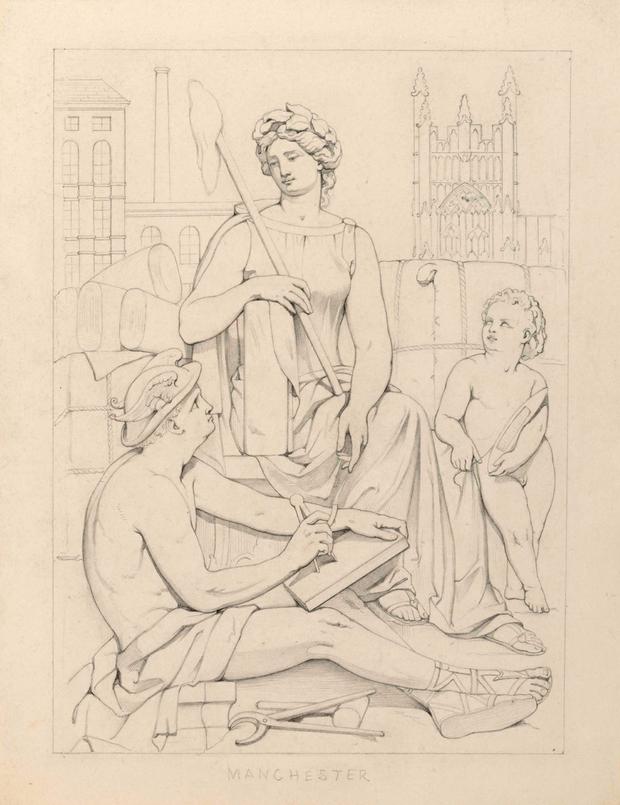
With such a reputation, it is hardly surprising that Thomas was engaged to decorate the new Houldsworth mansion at Park Terrace. One of Houldsworth’s biographers was later to claim that the magnificence of the designs, seen as impeccably innovative, was so much talked about that the Queen and Prince Albert paid a visit to the Thomas studio to inspect them.21 The expensive and elaborate scheme was nearing completion when cut short by Houldsworth’s death in 1859. Whilst it was seen by contemporaries as a ground-breaking scheme the furniture is untraced and little survives in the house of its original decorative arrangement.22 Our principal evidence for the character and scale of the scheme derives from a prospectus published in the Glasgow Herald for a contents disposal in 1861. Descriptive catalogues were also issued, but regrettably none have been located.23
During his lifetime Thomas was admired for his prodigious energy and versatility over a remarkable range of commissions completed within only a few years. He created sculpture for the railway bridge over the Menai Strait, Manchester Free Trade Hall and Leeds Town Hall, and completed many banking buildings across the country, all in the popular palazzo style (figs 10–11).

The same practice was designing Italianate garden ornaments and layouts, church furnishings, commemorative sculptures and even glass chandeliers, made by Osler of Birmingham, for the Sultan’s palace in Constantinople (fig. 12).24
Thomas also benefited from the small-scale reproduction of his work by the Art Union for whom leading manufacturers, including Minton, with whom Thomas had worked on many projects, produced ranges in Parian ware.25 One of his most acclaimed large-scale marble sculptures, Lady Godiva, now in Maidstone Museum, was reproduced in this way (fig. 13).26 Regrettably the V&A has no examples of Thomas Parian copies in its collection.
In 1849 the Art Journal reviewed the career of the promising young artist and found much to praise in his industry and quality because:
‘Nothing seems to come wrong to Mr Thomas in the shape of Art. His whole career shows a remarkable aptness for adaption: sculpture, carving, designing, drawing, painting, and architecture - he is equally at home in them all’.27
However, two obituarists in 1862 provided a rather more nuanced assessment of his achievements. One commented that his work was executed with scrupulous care and earnestness, rather faint praise perhaps. Another noted thoughtfully that he might have been an even finer sculptor had he been able to study antique sculpture in his youth, and devote greater time to his own development as an artist instead of being burdened with the supervision of major public and private building schemes.28

When in 1871 the artist William Bell Scott was celebrating the ‘school’ of British sculpture, he included Thomas in a survey that celebrated the more recognisable names in that canon, such as Flaxman, Nollekens, Chantrey and Gibson. Thomas was to be praised for his sureness, celerity of execution and commanding intelligence, because:
‘Perhaps there was no other man in England, or, we might say, in the world possessing the complete practical training with the versatile and inventive ability displayed by Thomas, under whom the whole could have proceeded so regularly and easily’.29
A more recent commentator has also observed that Thomas deserves credit for his part in breaking down snobberies within the sculptural profession.30

Thomas died in April 1862. He might simply have died from blood poisoning, but many friends felt that his death was hastened by disappointment. It was suggested that after considerable discussion, and not of the most conciliatory nature, the Royal Commissioners had refused him space for his Shakespeare monument at the International Exhibition of 1862 (fig. 14).**31**It seems a plausible account, especially as Thomas had lost his chief patron, Prince Albert, the previous year and lacked this protector to intervene in his cause.
It has to be conceded that Thomas’s reputation has declined sharply since the 19th century. It could be argued that to some extent he is tarred with the general disdain that befell Victorian sculpture in the 20th century, as new generations rejected the taste and imperialism of their forebears, a trend exacerbated by the disappearance of Victorian sculpture from the public realm as war time destruction and damage, and newly planned cities, redefined the landscape in which the work was originally created. In his seminal study, Benedict Read suggests that the fate that has befallen much Victorian sculpture has been ‘temporary oblivion or permanent destruction’ and notes that of almost three hundred British sculptures exhibited at the International Exhibition of 1862 few have survived.32 The Thomas survival rate, including his drawings as well as his sculpture, has been healthy by comparison with many of his contemporaries, though even so his remarkable collection of models for the Palace of Westminster were destroyed in the Crystal Palace fire of 1936.33 The decision to move his Rachel into a more prominent location provides an opportunity, albeit modest, to return his work and Victorian sculpture to public consciousness.
However, it is telling that Rachel has not secured a place in the Sculpture in England 1600–1900 galleries in the museum, which opened in 2007. Despite the generous space they occupy, curators of the new display still needed to make difficult choices, replete with aesthetic and historical judgements, about which works to display from the museum’s considerable collection. That process clearly concluded that Thomas was not essential to a particular narrative about British sculpture. Some would argue that Rachel has simply been moved from an entrance lobby to a new role as decorative object in a corridor; a period piece rather than a significant chapter in a story.
The problem of grading an artist such as Thomas is not, however, simply a recent one. Within his lifetime, sculptors and critics deliberated keenly about the nature of sculpture, the demarcation and status of the profession, and the quality of its invention. We have already seen how the Art Journal and William Bell Scott were fulsome in their praise for Thomas, whilst modest doubts were raised by others. It is interesting that Scott should have viewed Thomas as a member of the same British ‘school’ which embraced Sir Francis Chantrey because the career of the latter might explain why Scott was so anxious to situate Thomas within a vibrant sculptural tradition. The foundation of the Royal Academy of Arts in 1768, and its identification of sculpture as membership category, had a marked impact on the status of the profession. Following in these footsteps, some have suggested that Chantrey used the prestige and wealth from his remarkably successful career to formulate the concept of a national school in painting and sculpture; an objective confirmed by the fortune he bequeathed to the nation for the acquisition of art derived from this tradition.34 Thus it could be said that Scott takes his cue from Chantrey in his eagerness to identify Thomas, with his prodigious energy and range, as a fine exemplar of the breed.

Advocates for Thomas might also have felt that he had overcome some of the creative challenges that the painter Sir Charles Lock Eastlake had propounded for the sculptural profession. Eastlake became Secretary of the Fine Arts Commission in 1841- a body charged with the encouragement of British art and the interior decoration of the Palace of Westminster through which, one imagines, he must have encountered Thomas.35 Eastlake became President of the Royal Academy in 1850 and was later to become Director of the National Gallery. He also lectured on a wide range of artistic matters and his prognosis for sculpture was hardly cheerful because ‘sculpture is most liable to be particularly confounded with reality’ and ‘identity with nature is impossible in the chief object of imitation, the living figure’.36 One presumes that in works such as Rachel, Thomas had convinced many influential critics that he had been worthy of the challenge.
Although contemporary critics were largely supportive, tentative concerns were raised about the absence of academic rigour in Thomas’s training, and the potential unrealised as a result. A tougher view might have cited the deficiencies in his education, and the diversity of work, as evidence that Thomas typified the plight of British sculpture rather than its hope. The influential critic Michael William Rossetti writing in 1861, only a year before Thomas died, surveyed the condition and prospects of the national ‘school’ and despaired.37 He opined that true and beautiful form was the central object of sculpture, but feared that it was ‘too lamentably apparent’ that British artistry fell short of the ideal. He then proceeded to lament the poor training and patronage of sculptors, especially when compared to painters. Rossetti avers that in the absence of genius, and deadened by dependence on unimaginative patrons, ‘the tradesman like style of art takes comfortable possession’ and too many sculptors are ready enough to produce ‘Saint, king, or hero, Eve, Venus, nymph, shepherd, baby or allegory’.38 Whilst Rossetti does not name Thomas, and indeed he is circumspect in mentioning many artists directly, one might feel that these aspersions are a little near the bone when contemplating John Thomas. In the same year, Sir Richard Westmacott complained that ‘true’ sculpture was obscured by the sprawling diversity of workshops and their productions.39
While Thomas emerges from this narrative as a remarkable man, with a career forged through determination and energy, an art-historical perspective struggles to assign him a prominent role in the progress of British sculpture. However, it would be clinical and ungenerous to edit him too assiduously from the picture. He was a central player in forging the Palace of Westminster, a landmark project of that century, and was commissioned by some of the most prominent and engaging figures of his age. In this context, Thomas deserves respect and notice. By placing Rachel in a corridor adjacent to the Sculpture in Britain galleries, but not part of them or their scenario, Rachel, like her creator, stands in the wings rather than centre stage, a restaging that provides an elegant solution to what was an important omission, in the best ‘vision and accident’ tradition of the museum.
Acknowledgements
I am grateful to many colleagues for their support during the preparation of this article and would particularly like to thank Mary Witton, my personal assistant, for her research support; Timothy Stevens (author of the John Thomas entry in the Oxford National Dictionary of Biography) for nudging me in the direction of interesting source material; Charles Hind (Associate Director and H.J. Heinz Curator of Drawings and Archives Collections, RIBA) for providing painless access to the relevant RIBA holdings; James Stevenson (Photographic Manager, V&A) for creating the digital images; Doug Dodds (Head of Central Services, Word & Image Department, V&A) for scouring the V&A collections for all Thomas materials; and Mark Pomeroy for checking the records at the Royal Academy of Arts for the transactions arising from the Summer Exhibition of 1856. I am also most grateful to Julius Bryant (Keeper, Word and Image, V&A) Marjorie Trusted (Senior Curator of Sculpture, V&A) for their advice in the latter stages of completing this article. I am especially grateful to Greg Sullivan (Assistant Editor for the Biographical Dictionary of Sculptors) for his insights into the condition, and perceptions, of British sculpture in the 18th and 19th centuries and access to his unpublished research and lectures in this area; a generous deed on his part.
Endnotes
[26]: Atterbury, Paul (ed.). The Parian Phenomenon. Somerset: Richard Dennis, 1989: 80–1.
-
Art Journal. 1882: 144. ↩︎
-
Bilbey, Diane. British Sculpture 1470 to 2000: A Concise Catalogue of the Collection at the Victoria and Albert Museum. London: V&A Publications, 2002: 415 (catalogue entry 685). The second sculpture is The Hon. Alexander Francis Henry Campbell by Robert Jackson, which has a neat symmetry as he was chief assistant to John Thomas, see Bilbey, British Sculpture, 309 (catalogue entry 473). ↩︎
-
The Royal Institute of British Architecture (RIBA) holds a large collection of Thomas drawings (and some photographs of his works), all of which are viewable in the RIBA Architecture Study Room at the V&A. See RIBA Drawings Coll., Thomas, J. RIBA Drawings Catalogue. 15, 1971–84: 35–9 (2 vols). ↩︎
-
V&A Registry File. MA/1/H 3371, (Letter of 26 August, 1995, addressed to Philip Cunliffe Owen). ↩︎
-
Port, M.H. ‘Hunt, Sir Henry Arthur (1810–1889)’ in Oxford Dictionary of National Biography. Oxford: Oxford University Press, September 2004; online edition, January 2008. ↩︎
-
I am grateful to Mark Pomeroy in the Royal Academy of Arts Library for checking the exhibition records of that year to see if there is evidence of a sale. Unfortunately, no sale records survive. ↩︎
-
V&A Registry File. Memorandum of 15 September 1885. For George Wallis see: Roase, G.C. ‘Wallis, George (1811–1891)’ in Denis, Rev. R.C., Oxford Dictionary of National Biography. Oxford: Oxford University Press, 2004; online edition, October 2006. ↩︎
-
Art Journal. 1849: 340. ↩︎
-
Read, Benedict. ‘Sculpture and the New Palace of Westminster’, in The Houses of Parliament. London: Merrell, 2000: 253–68. ↩︎
-
Roscoe, Ingrid (ed.), A Biographical Dictionary of Sculptors in Britain, 1660–1851. New Haven and London: Yale University Press, 2009: 244–9. ↩︎
-
Port, M.H. ‘Peto, Sir (Samuel) Morton, first baronet (1809–1889)’, in Oxford Dictionary of Biography. Oxford: Oxford University Press, September 2004; online edition, May 2008. ↩︎
-
Roscoe, Ingrid (ed.), A Biographical Dictionary of Sculptors in Britain, 1660–1851. New Haven and London: Yale University Press, 2009: 1245. ↩︎
-
Stevens, Timothy. ‘Thomas, John (1813–1862)’ in Oxford Dictionary of National Biography. Oxford: Oxford University Press, September 2004; online edition. ↩︎
-
‘The Late John Thomas, Sculptor’. The Illustrated London News. August 30, 1862: 231–2. ↩︎
-
Handley-Read, Charles. ‘Prince Albert’s Model Dairy’. Country Life. June 29,1961: 1524–6. ↩︎
-
Handley-Read, Charles. ‘Prince Albert’s Model Dairy’. Country Life. June 29,1961: 1526. ↩︎
-
Roberts, Hugh. ‘The gem of the Palace: Queen Victoria’s Audience Room at Windsor Castle’. The Burlington Magazine. December 2009: 824–9. ↩︎
-
Illustrated London News. August 30, 1862, 232. ↩︎
-
Roberts, Hugh. ‘The gem of the Palace: Queen Victoria’s Audience Room at Windsor Castle’. The Burlington Magazine. December 2009: 826. ↩︎
-
Fairfull Smith, George. ‘Furniture and Plenishing for 1 Park Terrace Glasgow: A little known commission design by John Thomas’ in Furniture History. XXXIV (1998): 266–78. ↩︎
-
Fairfull Smith, George. ‘Furniture and Plenishing for 1 Park Terrace Glasgow: A little known commission design by John Thomas’ in Furniture History. XXXIV (1998): 268. ↩︎
-
Fairfull Smith, George. ‘Furniture and Plenishing for 1 Park Terrace Glasgow: A little known commission design by John Thomas’ in Furniture History. XXXIV (1998): 271. ↩︎
-
Fairfull Smith, George. ‘Furniture and Plenishing for 1 Park Terrace Glasgow: A little known commission design by John Thomas’ in Furniture History. XXXIV (1998): 270. ↩︎
-
Stevens, Timothy. ‘Thomas, John (1813–1862)’ in Oxford Dictionary of National Biography. Oxford: Oxford University Press, September 2004; online edition. ↩︎
-
Read, Benedict. Victorian Sculpture. New Haven & London: Yale University Press, 1982: 65. ↩︎
-
Art Journal. 1849: 340. ↩︎
-
Art Journal. 1862: 144; Illustrated London News. August 30, 1862: 232. ↩︎
-
Bell Scott, William. The British School of Sculpture. London: Virtue and Co, 1871: 79–81. ↩︎
-
Read, Benedict. Victorian Sculpture. New Haven & London: Yale University Press, 1982: 272. ↩︎
-
Art Journal. 1862:144. ↩︎
-
Read, Benedict. Victorian Sculpture. New Haven & London: Yale University Press, 1982: 3–45. ↩︎
-
Read, Benedict. Victorian Sculpture. New Haven & London: Yale University Press, 1982: 37. ↩︎
-
I am greatly indebted to Greg Sullivan for offering his insight into the evolving character of British sculpture and the crucial role played by Chantrey, all derived from his (unpublished) lectures on this subject. Sullivan was one of the Assistant Editors on the Biographical Dictionary of Sculptors (New Haven and London: Yale University Press, 2009) and after many years of research is eminently qualified to comment on the British sculptural narrative. ↩︎
-
Robertson, David. ‘Eastlake, Sir Charles Lock (1793–1865)’ in Oxford Dictionary of National Biography. Oxford: Oxford University Press, September 2004; online edition, May 2008. ↩︎
-
Lock Eastlake, Charles. Contributions to the Literature of the Fine Arts. London: John Murray, 1870: 63–96; 95. ↩︎
-
Michael Rossetti, William. ‘British Sculpture, its condition and prospects’ in Fraser’s Magazine. April 1861: 493–505. See also Thirlwell, Angela. ‘Rossetti, William Michael (1829–1919)’ in Oxford Dictionary of National Biography. Oxford: Oxford University Press, 2004. ↩︎
-
Michael Rossetti, William. ‘British Sculpture, its condition and prospects’ in Fraser’s Magazine. April 1861: 494. ↩︎
-
Sullivan, M.G. ‘Stuart and the changing relationship between architects and sculptors in eighteenth-century Britain’, in James ‘Athenian’ Stuart 1713–1788: the rediscovery of antiquity, edited by Susan Weber. New Haven and London: Yale University Press, 2006: 385–411; 308. See also: Busco, Marie ‘Westmacott, Sir Richard (1775–1856)’ in Oxford National Dictionary of Biography. 2004; online edition, Jan 2009. ↩︎
